2 Volumes
Sociology: Philadelphia and the Quaker Colonies
The early Philadelphia had many faces, its people were varied and interesting; its history turbulent and of lasting importance.
Nineteenth Century Philadelphia 1801-1928 (III)
At the beginning of our country Philadelphia was the central city in America.
City of Homes
At first, there were limitless forests, but then the city burned down. After that, the "Red" city has long been built of brick. Philadelphia's masonry future is unknown, but it won't be wood.
Home Heating Issues
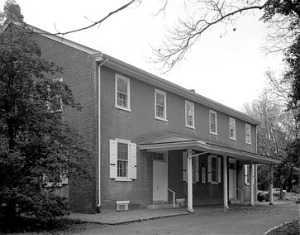
|
| Haddonfield Friends Meeting House |
Like all churches, the Haddonfield Meetinghouse has a big heat bill expense, and only needs to keep the place warm a couple of times a week. So more attention than usual is paid to this expense, which is a considerable one if viewed as dollars per hour used. Inevitably, a large body of members will contain a few who are in the heating business or close enough to it to have a strong opinion. And then, there is the environmental movement.
In my house, I burn about 1200 gallons of oil a year; my auto use is more moderate, I burn less than 500 gallons a year of gasoline. Everyone will have a unique set of figures. For me, the house is a bigger polluter of the atmosphere than the car. Even if others are big auto users, the heating of houses remains a major environmental issue, with much less public agitation about it than about cars. Remember, most people require heat at two places in the winter, where they live, and where they work. Half of this relates to the heating of churches, too, which is where the discussion begins but first wanders a little. But someone also has to heat your drugstore, your supermarket, and your schools.
In the first oil crisis, when Jimmy Carter was President, one of the Haddonfield members arranged some sort of switch arrangement allowing the Meeting to convert from oil to gas and back, as the price levels fluctuated. As I recall, he reported the Meeting saved $5000 in the first year. Just how this was done I never learned; that particular oil shortage was over before I got around to looking into it for my own home. But now disturbances in the Middle East have made imported oil more uncertain, and refineries were built in the Middle East with the oil profits, so our own refineries along the Delaware River are closing down, making petroleum products more uncertain for us. Meanwhile, it has been discovered the state of Pennsylvania is sitting on top of as much shale gas as Arabia has oil underneath it, and new ways have been developed to extract the gas. So, the long-term view is that fuel oil will get more uncertain, while gas is at least likely to be more available. In both cases, the effective price to the consumer will be at the mercy of politicians in state government, scientists who seriously study the question of global warming, and unstable personalities who periodically tell us the sky is falling. Therefore, the long term prospect is that gas heating will probably be cheaper and more dependable than oil, but the almost certain prospect is that this ratio will jiggle up and down depending on politicians and bouts of public hysteria. The average homeowner only lives in the average house for seven years, but a furnace will be replaced once in forty or fifty years. Add all of this up, and the following conclusions are reached:
1. It's probably better if new houses install gas furnaces, and old oil furnaces should probably be replaced by gas as they wear out. Better for the environment, and cheaper in the long run. Unless you have a better plan, which we will here propose.
2. Most homeowners have less than a seven-year horizon for living where they are, so they ignore the long term and depend on their luck about the sudden discovery that the furnace isn't working tonight, by playing the odds, rather than thinking about it in advance. This leads to short-term concentration on the emergency installation cost differential rather than the long-term costs which are really considerably greater. The heating crisis generally happens to people who never gave the matter a moment's thought until the house suddenly got very cold, and who therefore cannot cope with the claims and potentially self-serving arguments of the emergency repairman.
3. The old furnace doesn't work, so it gets removed and replaced. The argument put forward here is you should look into the matter during warm weather, request bids, educate yourself about the topic, particularly if your present furnace is more than thirty years old. And then, don't remove the old one, just add a new one right next to it in the basement.
4. Furthermore, don't worry about switches or commercial dual-fuel furnaces designed to heat a high school. Just get a high-efficiency furnace of the opposite fuel requirement from what you have, and control both of them with separate thermostats. You "switch" between them by setting one thermostat for a higher temperature than the other; in my case, 58 degrees for oil, 68 degrees for gas. If you have been to Florida and the house is really cold, both furnaces will work, and the house will warm up in an hour.
5. That's the essence of it, but there are a few other things you had a better look into.
* * *

|
| Forced Air Heat |
Let's resume by noticing that most people have a separate hot-water heater in the basement, right next to the furnace, using the same chimney; but the water heater already burns gas. If that's the case, there is no problem with availability and plumbing for gas. However, if a gas heater and an oil burning furnace sit side by side, the oil burner is helping the water heater. That's because oil is less efficient (68% in 1950, 85% in 2010), while gas is more efficient (95% in 2010). As a consequence, the exhaust from an oil burner is hotter than the exhaust from gas and creates more of an updraft in the chimney. With the removal of an oil burner, the hot water heater is stranded, and may not be able to blow its own gases out the chimney. While there is a lot of room for skepticism of the buyer-beware variety, this is the argument behind requiring a ceramic chimney liner for oil heat, but a stainless steel pipe for gas. You can accept this scientific explanation or you can simply rely on the Code, which requires it to be that way. There's a lot of fast-talk involved in many features of the Building Code, and many people find it to be satisfactory to find illegal ways to get around the politically-inspired Code. So, building permits are required, and building inspectors enforce it.
So, one of the hidden costs of converting from an oil heater, is the cost of the stainless steel pipe. I've been quoted upwards of $3000 for this little feature, so it must be considered and preferably negotiated into the cost of heater conversion. Most people would say that $3000 is a lot of money for a pipe.
There's an alternative, but not a completely satisfactory one of putting the exhaust pipe laterally out the window. There's likely to be soot, damage to shrubbery, outside noise, and the potential for unsightly workmanship. Birds, squirrels, and raccoons may find your abandoned chimney to be more, or less, attractive as a place to nest. Some upstairs rooms may have received heat from the warm chimney and may seem notably colder if the chimney gets cooler. Fireplaces in the bedroom are less popular than they once were, but in old houses, this might present some issues.
Now there's also asbestos to talk about. Careless use of asbestos seems to have been particularly common during World War II in the Navy and Naval shipyards. At least, I practiced medicine actively for forty years without seeing a single case of asbestosis, or mesothelioma. But I have since had two close friends, one a Chief of Naval Operations, and the other the principal inventor of the artificial kidney, who died of mesothelioma, a particularly nasty cancer caused by asbestos. It's a nasty business, but the poisonous effects were unknown before 1955, and then only in South Africa. But it's rare, and particularly rare outside the Navy. It's hard to justify the billions of dollars being lost by bankrupting Johns Manville and other builders who acted in good faith before the danger was known. It's particularly obscene to watch respected physicians give guarded testimony which is twisted into multi-million dollar claims of injury for what is only a dubious x-ray shadow; the doctor didn't say that the lawyer said it, but said it in a way that suggests the doctor agrees with him. The particular relevance of the matter here has to do with removing asbestos from an old house. Old furnaces contain asbestos; there's no penalty for leaving it alone, but a big one for removing it. If your old water heater was encased in covered asbestos, the hot water salesman will give you a new one but refuses to touch the old one except to drag it into a corner for you. The prices these guys charge for touching asbestos in any way that qualifies as "removing" it are appalling. Yes, it's true that tearing it off the pipes stirs up dust in the air, and is probably more hazardous than leaving it alone; it's certainly more hazardous if you do it yourself, at night. So it's an argument for leaving the old furnace in place and adding a new one, and it introduces a cost factor that must be fairly faced. So, it serves my argument to mention it, but I wish it would be widely ignored.
So there you are warts and all. It's easy to predict that dual-fuel complex furnaces are not likely to sweep the nation, even though it's also easy to demonstrate there is every reason to switch to them. What's been removed is the social pressure of doing what everyone else is doing, a powerful force in our consumer society. The market for this mildly complicated arrangement lies in institutions, which believe they are perpetual. After them, the first-adopters will straggle local merchants and long-term suburban residents, like doctors and lawyers. It inflicts short-term pain for long-term gain, not likely to appeal to anyone living on maxed-out credit cards. But where else can you recover your investment in three years? Where else can you get a 33% after-tax return on any investment?
Supra Complex Heating Systems
At the beginning of 1979, the price of domestic heating oil began to soar. Because natural gas was controlled by the Federal Government, this price remained fixed. It was evident that anyone who could switch from oil heat to gas heat would benefit greatly by doing so.
My home is a large Victorian house with 11 rooms that was built about 90 years ago. The House is not particularly well insulated, although it is very well built. The heating system was an old coal boiler that had been converted to oil. The oil burner itself was only 3 to 4 years old. The cost of converting to gas was approximately $2,300 and the saving that would result from the use of the less expensive gas was such that the payback period would be 3 years. It made economic sense to me to invest in this capital expenditure when the payback period was such a relatively short one.
To begin with, I would like to analyze the existing oil burner system. Feed water enters the system by means of an automatic valve that is set at a specific pressure. Water enters the system until that pressure was obtained and would then shut off. If the water exceeded a certain higher pressure, a relief valve opened allowing the water to escape from the system. An aquastat controlled the boiler water temperature and a circulating pump moved the water to the radiator when the thermostat called for heat.
The domestic hot water was also heated by this oil fired coal boiler. This was done by means of a summer/winter hook up consisting of copper immersed in the boiler water and an 80 gallon insulated storage tank that would collect the heated water.
When I first considered installing a new gas-fired boiler, the plumber suggested that I take out the old system and replace it with a new one. However, I saw no reason to do this as it was in good working condition. I decided that I would design a new system to work in parallel with or instead of the first system.
There was plenty of room in the basement and, since a hot water system lends itself to the type of arrangement P had in mind, it was relatively easy and practical to design a tandem system that could be operated in conjunction with or instead of the original one. The new system is basically very similar to the old one except it is fired by gas instead of oil. However, there are some significant differences. One is in the domestic hot water is heated. This is done by means of an instantaneous hot water coil. No storage tank is necessary because the rate at which hot water is used is less than the rate at which it can be heated. You can use hot water all day and all night and still have a sufficient supply. That theory is based on just one use at a time. In my house, two people cannot take showers at the same time in two different bathrooms because one would not have enough water pressure.
Because of the nature of the domestic hot water heating system in the gas furnace, it was decided to use the hot water storage tank from the oil burner system as a tempering tank for the new furnace. Cold water would come in from the main at approximately 45.F and would stay in the tempering tank in the basement and warm up to the ambient air temperature. The end insulation was removed to facilitate this. The water would then feed into the gas burner for heating up to approximately 120.F
After I had made my design, I reviewed it with the plumber and he suggested some practical inputs that I as an engineer hadn't considered. For instance, in using an instantaneous hot water system, a restrictor has to be put in the line so that the flow of hot water through the coil is not so rapid that the water flows through faster than the furnace can heat the water.
With the two systems that can be used together or separately, I have actually created a supra-system that can be operated in different ways. The normal way and the way that it is operated most of the time (now that natural gas is a good deal cheaper than oil) is as a gas burner with the burner domestic hot water storage tank acting as the tempering tank. A second way is to operate as an oil burner, just as previously, with the domestic hot water heated by the oil burner and stored in the storage tank. Both Systems can be operated together and this is done occasionally for very practical reasons. If I go on a trip in the winter and lower the temperature to 50.F and, upon returning, wish to increase the temperature in the house as rapidly as possible, I will put both systems on and can bring the house up to a comfortable temperature in about 1-1/2 to 2 hours. With just one furnace, it would take close to 4 hours. A third method that can be used, although I think it is an impractical one, is that you could use one burner to heat the house and the other one to heat the domestic hot water.
There are also two other combination's. You could use the oil burner to heat the house and use both the gas burner and the oil burner to heat the house and use both the gas burner and the oil burner to heat the hot water. You could also use the gas burner to heat the house and use both oil and gas burner to heat the water. This is really not a practical hook up and the only time it would conceivably be used as if one of my daughters was having a big house party where there would be a lot of showers, baths and shampoos and the girls wanted a guaranteed unlimited supply of hot water for the occasion.
One mistake that I believe was made in assembling the new system was that a separate feed water valve connected to the new furnace. I believe this occurred because the new furnace came equipped with the feed valves and, instead of just trying it into the existing feed water valves, the plumber automatically used the valves that were supplied. The system works satisfactorily the valves that were supplied. The system works satisfactorily this way but this unnecessary complexity did cause trouble once last winter. One of the radiators on the third floor cracked during a severe cold spell. I noticed the water leaking from the radiator on the third floor and the first thing I did was to turn off the feed water system. I had forgotten, however, that there were two feed water systems going into the Supra-system and, initially, couldn't understand why the water kept flowing from the cracked radiator. This is an example of the system becoming too complex so that, in reality, it becomes very cumbersome to control. Since I was the one who designed the system and was intimately familiar with it, I should have been fully aware of the fact that there were two feed water valves going into the supra-system. However, with the excitement of the cracked radiator and the dripping water, I had forgotten about this until I investigated thoroughly why the water had not stopped flowing.
Two other slight problems occurred that could not have been anticipated. One was that with the use of the modern designed high capacity circulating pump, a resonant type hum occurs when the system is calling for heat. This doesn't seem to be very noticeable in any room except the master bedroom and it became easier to get used to the hum rather than replace this circulating pump with a lower capacity one. The Second problem that developed was that as soon as the temperature in the boiler dropped below a certain point, the circulatory would shut off to allow the water temperature in the boiler to water from getting too cool, thereby cooling off the instantaneous hot water coil. This intermittent use of the circulator pump caused one particular radiator on the first floor no to get very warm because the circulator itself was only operating for a short period of time the hot water seemed to have trouble in getting to this particular radiator.
A complex as my new heating system seems to be, I believe it is a practical system for several reasons. First, it cost less to put the new system in tandem with the existing system than it would have to tear out the old and replace it with the new system. Second, by having two systems I have great flexibility as far as what kind of fuel to use. If the price of natural gas goes higher than oil, in less than one minute I can switch from gas to oil. Third, if one of the units develops a problem, the other unit can be brought on the line very rapidly and the house will stay warm. Fourth, the house can be brought up to temperature in approximately one-half the normal time because of the double heating capacity that is now in existence. Fifth, great flexibility was obtained with the domestic hot water system.
If the price of natural gas approaches oil while coal stayed low so that the installation of a coal furnace would have a payback period of 3 years or less, I would not hesitate in adding a third furnace. This might seem completely idiotic but, if it will pay for itself within 3 years, it would make economic sense. Since I have the room in the basement to keep adding furnaces, why not? of course one of the disadvantages of creating a supra-system that has approximately four times the complexity of a simple system is the difficulty in controlling it. Witness the problem that I had during the emergency of the cracked radiator! When I eventually sell my house, the new owner might be completely baffled by this complex system. Of course, all the valves and switches are labeled but, even so, it can be difficult understanding which valve to turn at which time. If the owner is completely ignorant when it comes to mechanical and electrical devices, he could solve the problem by just setting the system once and, when he feels he wants to change he could call the plumber.
One of the requirements, when a homeowner switches to gas heat in New Jersey, is that the house has storm windows. Another is that the system be controlled by a clock type thermostat works very nicely on a small house or on a house that has over 20 large cast iron radiators does not work properly from a practical aspect. What happens is that, if you lower the thermostat 5 to 10 degrees for night operations, when the thermostat calls for the day temperature the next morning, the furnace comes on and has to work very hard to heat enough water to raise the temperature of the whole system. By the time the house does come up to the day temperature, the cast iron radiator is so hot that, even though the furnace shut off, the temperature continues to rise about five degrees. The reason is that the cast iron radiators hold the heat and, even though the furnace has turned off, the house temperature goes up making it very uncomfortable and also defeating the purpose of the day/night thermostatic setting.
I had suspected that this would be the case, although I was not sure. The practical solution to this problem was that after the Public Service of New Jersey inspector made his rounds and saw that I compiled it every way, I then took out the clock thermostat and sent it back to the dealer and exchanged it for a regular single setting thermostat.
Since both heating systems can be used together and since each one has various sensing controls, one of the statements made by J.G. Miller in his book, The Need for a General Theory of Living Systems, would also apply to this heating system. Specifically, he said, "if there are multiple parallel deciders without a hierarchy that has subordinate and supra-ordinate deciders, there is not one system but multiple systems". In a sense, this is what I would have if I used the oil burner to heat the domestic hot water but then fed this domestic hot water into the gas burner instantaneous hot water coil to further heat it. Miller also talks about joint subsystems and he defines that as, "the case when a system is dependent for the process on a component it shares with another system". In my heating system, this would be the case with the 80-gallon storage tank. In one used as a storage tank for domestic hot water and yet, in another method of operation, it is used as a tempering tank for the instantaneous hot water coil in the gas unit. This same tank can also be used as part of a preheating system in conjunction with the instantaneous hot water coil.
Miller also talks about passive adaptation and, as an example, he talks about a heater controlled by a thermostat. Since I have two heaters controlled by two different thermostats, this is a very good example of passive adaptation and it can be used in such a way that if, for some reason or other unit to heat the domestic hot water, this could be achieved by setting the thermostat for the home heating at the desired temperature while the thermostat for the heater that was to heat the domestic hot water would be placed at a lower temperature to ensure that particular heater circulation would not come on to heat the house.
Another advantage of my supra-system is it provides a back up in the event that the house is empty and the primary heater fails to function. This can be achieved with my dual system by setting one thermostat at, let's say, 50.F and the other thermostat at 45.F. The way this would work is that normally the house would be heated, for instance, by the gas furnace and the temperature in the house would remain at 50.F. However, if something happened to the gas furnace and the unit did not come on, the oil furnace would automatically come on when the temperature dropped to 45.F, thereby providing insurance against many cracked pipes and radiators.
The way my two heating systems are interconnected, they can be operated either as an integrated system or as a segregated system, depending on the requirements at the time. According to Miller, " the more integrated a system is, the more one part is likely to influence or control another". Generally speaking, however, my system is operated as a segregated one except for unusual circumstances. The two systems are very compatible and, if both are working at the same time, they work together without any conflict.
Miller maintains, "The general direction of evolution is towards greater complexity". He made this statement in relation to living systems but I believe this statement is also true in mechanical systems. As we evolve our various mechanized units, whether they be automobiles, airplanes or heating systems, the direction is towards increased complexity rather than greater simplicity.
Bergdoll the Rich Draft Dodger
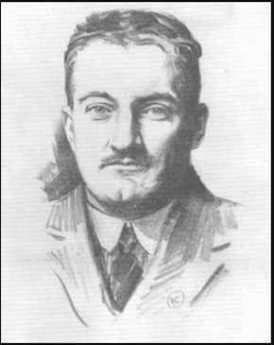
|
| Grover Cleveland Bergdoll |
Grover Cleveland Bergdoll was one of the great playboys during the era between the Spanish American War and World War I. Although the money came from his beer-baron father, he was in the newspapers as one of the early owners of an airplane, one of the dare-devils racing about in open cars, and of course successful with girls.
His father Louis (1825-94) had emigrated from Germany, bringing with him the new technique of making lager beer by brewing it in the cold, and quickly exploiting its popularity into thousands of barrels of beer a day. Although it is always hard to say just who invented a technique like that, there seems little doubt that Bergdoll & Schemm was responsible for transforming the area north of Spring Garden Street into a booming area of breweries, consuming huge amounts of ice and ice water, wood staves for beer barrels, horses to drag beer to the beer gardens, and energizing railroads to import raw materials and carry away the barrels of beer. The refrigeration industry flourished and spread out into air conditioning. Bergdoll was a mighty force in Philadelphia industry.

|
| Bergdoll Mansion |
The Bergdoll house was located on 21st Street, not far from the Eastern State Penitentiary, in the very upscale neighborhood called Fairmount. The neighborhood was isolated by the "Chinese Wall" of the Pennsylvania Railroad, and more importantly by the slashing through of the Benjamin Franklin Parkway. Eventually, the advent of Prohibition destroyed Philadelphia's brewery industry and its associated beer gardens. The Fairmount region declined into a slum, particularly after the 1929 Stock Market Crash, and upper crust Philadelphia fled blocks and blocks of huge mansions, too big to heat and clean, and also too big and substantial to tear down. So the Bergdoll mansion has been there all along, but there was just no one around to look at it. With the gentrification of the Fairmount region at the turn of the 21st Century, there it sits. a brownstone Pyramid, or Parthenon. A lot of wild stories circulate in the neighborhood, but very few of the new neighbors know very much about it.
It's just possible that the brownstone Widener mansion on North Broad Street is bigger, and certainly the Elkins, Stotesbury and Montgomery mansions in the far suburbs are a lot bigger. But this brownstone edifice in the center of town is impressively large enough to count for something, filling roughly half a square block if you include what look like stables of the same architectural style, and the double houses which suggest some members of the family lived next door. Even these smaller outbuildings are a great deal larger than the average city mansion.
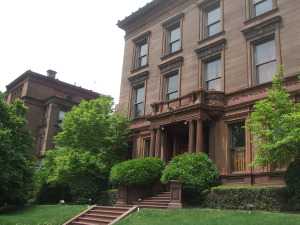
|
| Bergdoll Mansion |
The size of the place makes it easier to understand how Grover Cleveland Bergdoll could be hidden there as a draft dodger for years. In fact, local rumor often has it that he stayed there for thirty years, but it was really only about three. A book by Roberta E. Dell, called The United States Against Bergdoll supplies considerably more detail. One has to suppose that this strongly German family was opposed to American participation in World War I, and the government's violent reaction to his draft objection reflected concern that the very large German-American population might rise up and interfere with Woodrow Wilson's decision to enter the War on the Allied side. In any event, Grover's mother hid him away in the extensive mansion complex until that war seemed safe over, but he was immediately apprehended and put on trial when he emerged. Somehow or other, he managed to convince the authorities that he should be released under guard in order to go dig up an enormous fortune in gold that he had buried. The agents guarding him were put up as guests in the big mansion, apparently unable to resist the big treat. But it was a ruse, a getaway was waiting and off he sped, ending up in exile in a little town a few miles from Heidelberg, Germany. It was there that he married a local German girl and spent an apparently comfortable exile until after the Second World War. There were rumors and stories, however. A couple of kidnappers broke in on him in an apparent effort to take him over the French border, but Bergdoll killed one of them. Even after World War II, all was not forgiven; he came home, was immediately apprehended and tried, and spent a brief time in jail. He died in 1966.
Those who are sufficiently fascinated by his story, can even live in his house. It's been renovated, and rents out as Bergdoll Mansion Apartments.
Selling Entire Towns

|
| Jason Duckworth |
Recently, Jason Duckworth of Arcadia Land Company entertained the Right Angle Club with a description of his business. Most people who build a house engage an architect and builder, never giving a thought to who might have designed the streets, laid the sewers, strung out the power and telephone lines, arranged the zoning and otherwise designed the town their house is in. But evidently it is a very common practice for a different sort of builder to do that sort of wholesale infrastructure work -- privatizing municipal government, so to speak. A great deal of what such a wholesale builder does involves wrestling with existing local government in one way or another, getting permits and all that. In a sense, the existing power structure is giving away some of its authority and does so very cautiously. Sometimes that involves suing somebody or getting sued by somebody. Perhaps even greater braking-power on unwelcome change is that the wholesale builder is in debt until the last few plots are sold, and realizes his profit on stragglers. Since it often happens that the last few plots are the least desirable ones, this is a risky business. Big risks must be balanced by big profit potential, and one of the risks of this sort of privatization is that too much consideration may be given to the players at the front end, the farmer who sells the land and the builder who must keep costs down, at the expense of the long-range interests of the people who eventually live in the new town. Top-down decision making is much more efficient, but its price is decreased responsiveness to citizen preferences.

|
| For Sale |
As it happens, Arcadia specializes in towns designed to look like those built in the late 19th Century. Close together, a front door near the sidewalks, front porches for summer evenings. To enhance the feeling of being in an older village, Arcadia specifies certain rules for the architecture, to make it seem like Narberth or, well, Haddonfield. Until recently, suburban design emphasized larger plots of land, and few sidewalks, with streets often ending in cul-de-sacs instead of perpendicular cross-streets in the form of squares. The "new urbanism" appealed to those who were seeking greater privacy, revolving around the idea that if you wanted anything you drove your car to get it. Three-car garages were common, groceries came from distant shopping centers. There are still plenty of new towns built like that today, but Arcadia appeals to those who want to be close to their neighbors, want to meet them at the local small stores scattered among the houses. In the 19th Century, this sort of town design was oriented around a factory or market-place; since now there are seldom factories to orient around, the appeal is to two-income families who want to live in an environment of similar-minded contemporaries. The whole community is much more pedestrian-oriented, much less attached to multiple automobiles.
Since Mr. Duckworth mentioned Haddonfield, where I live, I have to comment that the success of living in a town with older houses depends a great deal on the existence of a willing, capable yeomanry. Older houses, constantly at risk of needing emergency maintenance, need available plumbers, roofers, carpenters, and handy-men of all sorts. Because it is hard to tell a good one from a bad one until too late, this yeomanry has to be linked together invisibly in a network of pride in the quality of each other's work and willingness to refer customers within a network that sustains that pride. A tradesman who is a newcomer to the community has to prove himself, first to his customers, and almost more importantly to his fellow tradesmen. If you happen to pick a bad one, good workmen in other trades are apt to seem mysteriously reluctant to deal with you as a customer, because you too are somewhat on trial. Maybe you don't pay your bills, or maybe you are picky and quarrelsome. In this way, the whole community is linked together in a hidden community of trust. Over time, the whole town develops certain recognizable social characteristics that a brand-new town doesn't yet need. If that time arrives without a network of reliable tradesmen, the town soon deteriorates, house prices fall, people move away.
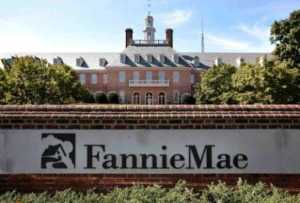
|
| Fannie Mae |
It's curious that the residents of such a town are a breed apart from the merchants in the nearby merchant strip. If the merchants of town life in that same town, there is much less conflict. More commonly, however, the merchants rent their commercial space and commute from distant places. That disenfranchises them from voting on school taxes and local ordinances and creates a merchantile mentality as contrasted with a resident community, dominated by high school students. One group wants lower taxes, the other group wants to get their kids into Harvard. One group wants space for customer parking, the other group is opposed to asphalt lots. And in particular, the residents want to avoid garish storefronts and abandoned strip malls. Since the only group which has an influence on both sides of this friction are the local real estate agents and landlords, their behavior is critical to the image of the town. When real estate interests are not residents of the town it is ominous, and they are well advised to remember that the sellers of houses are the ones who choose a real estate agent for a house turn-over. There's more to this dynamic than just that, but it's a good place to begin your analysis. Suburban real estate interests are constantly tempted to get into local politics, but politicians are the umpires in this game, and it soon becomes bad for their business if real estate agents potentially put their thumb on the scales.

|
| FHA Seal |
All politics is local, but all real estate is not entirely local. The present intrusion of the Federal Government into what is normally a purely local issue has become more pointed in the present real estate recession. Almost all mortgages are packaged and sensitized by "Fannie Mae and Freddy Mac". By overpaying for the mortgages they package, these two federal agencies are subsidizing the banks they buy the mortgages from. Or, that is half of the subsidy. The other half is the Federal Reserve, which presently lends money to banks at essentially zero interest. Acquiring free money from the "Fed", while selling mortgages to Fannie Mae at above-market rates, the federal government supports the banks at both ends. And that's not quite all; there is something called the FHA, Federal Housing Authority, which guarantees mortgages. Essentially an insurance policy, the FHA guarantee is issued for a cost to home buyers who meet standards set by Congress (for which, read Barney Frank and Chris Dodd). Although houses during the boom were selling for 18 times the estimated rental value, they are now selling for 15 times rental. FHA will insure such risks, but the banks won't lend more than the normal proportion, which is 12 times rental. Consequently, almost all mortgages are FHA insured, while the federal administration storms with a fury that the banks "won't lend". And indeed it begins to look as though banks will never issue uninsured mortgages until home prices fall another 25%. If home real estate prices do decline to a normal 12 times rental, a lot of people (i.e. voters) will be unhappy, and not just homeowners who bought at higher prices. The market is fairly screaming that you should sell your house and rent, but so far at least, these federal subsidies seem to be holding prices up. When normal pricing arrives, the recession is just about over, but it certainly won't feel that way if you are a seller.
Frank Furness (2) Rittenhouse Square
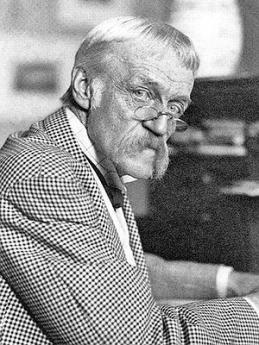
|
| Frank Furness |
George Washington had two hundred slaves, Benjamin Chew had five hundred. It wasn't lack of wealth that restrained the size and opulence of their mansions, particularly the ones in the center of town. The lack of central heating forced even the richest of them to keep the windows small, the fireplaces drafty and numerous, the ceilings low. Small windows in a big room make it a dark cave, even with a lot of candles; a low ceiling in a big room is oppressive. Sweeping staircases are grand, but a lot of heat goes up that opening; sweeping staircases are for Natchez and Atlanta perhaps, but up north around here they aren't terribly practical. Building a stone house near a quarry has always been practical, but if there is insufficient local stone, you need railroads to transport the rocks.
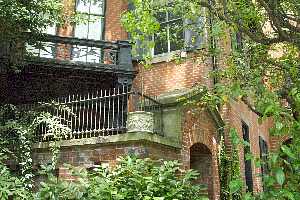
|
| Early Victorian |
So to a certain extent, the advent of central heating, large plates of window glass, and transportation for heavy stone and girders amounted to emancipation from the cramped little houses of the Founding Fathers. Lead paint, now much scorned for its effect on premature babies, emancipated the color schemes of the Victorian house. Many of the war profiteers of the Civil War were indeed tasteless parvenu, but it is a narrow view of the Victorian middle class to assume that the overdone features of Victorian architecture can be mainly attributed to the personalities of the Robber Barons. This is not the first nor the only generation to believe that a big house is better than a small one. The architects were at work here, too. It was their job to learn about new building techniques and materials, and they were richly rewarded for showing the public what was newly possible. Frank Furness was as flamboyant as they come, a winner of the Congressional Medal of Honor for heroism, a man who wore a revolver in Victorian Philadelphia and took pot-shots at stuffed animal heads in his office. He affected the manners of a genius, and his later decline in public esteem was not so much disillusion with him as with the cost of heating (later air-conditioning), cleaning, and maintenance which soon exceeded provable utility. The simultaneous arrival of the 1929 financial crash and inexpensive automobile commuting to the suburbs stranded square miles of these overbuilt structures. It was the custom to build a big house on Locust, Spruce or Pine Streets, with a small servant's house on the back alley. During the Depression of the 1930s, there were many families who sold the big house and moved into the small one. Real estate values declined faster than property taxes and maintenance costs; incomes declined even faster.
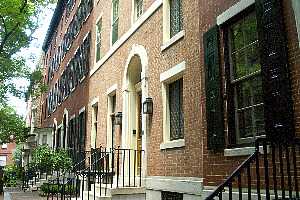
|
| Delancey Street |
It thus comes about that large numbers of very large houses have been sold for very modest prices, and the urban pioneers have gentrified them. You can buy a lot of house for comparatively little if you are willing or able to restore the building. We thus come back to Frank Furness, who was the idolized architect of the Rittenhouse Square area, in addition to the massive banks and museums for which he is perhaps better known. Unfortunately, most of the Furness mansions on the square have been replaced by apartment buildings, but one outstanding example remains. It's sort of dwarfed by the neighboring high-rises, but it was originally the home of a railroad magnate, a few houses west of the Barclay Hotel, and it holds its own, defiantly. Inside, Furness made clever use of floor-to-ceiling mirrors to diffuse interior light and make the corridors seem wider. Although electric lighting made these windowless row houses bearable, modern lighting dispels what must have been originally a dark cave-like interior on several floors, held up by poured concrete floors. Furness liked to put in steel beams, heavy woodwork, and stonework, in the battleship school of architecture. If you were thinking of tearing down one of his buildings, you had to pause and consider the cost of demolition before you went ahead.
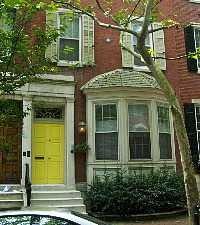
|
| Frank Furness Window |
There are several others of his buildings around the corner on the way to Delancey Street, one of them set back from the street with a garden in front. That's what you expect in the suburbs, but the land is too expensive in center city for very many of them; this is the last one Furness built before rising real estate costs drove even him back to the row-house concept. On Delancey Street, there is a house which he improved upon by adding an 18-inch bay window in front. The uproar it caused among the neighbors is still remembered.
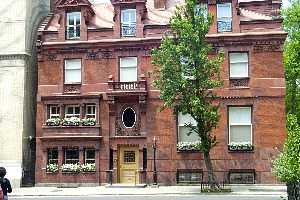
|
| Doctor Home and Office |
A block away on the part of 19th Street facing down the street, Furness built another reddish brownstone house to glare back at the neighbors. The facings of the front suggest three-row houses, and it was indeed the home of a physician who had his offices on one side, entrance in the middle, and living room on the right. The resulting staircase in the middle is used to good effect by opening a balcony on the landing overlooking the parlor below. As befits the Furness style, the wall is thick, the wooden beams heavy. And, in a gesture to the lady of the house, the room adjoining the living parlor is a modern kitchen so the kids can play while mama cooks or guests can wander by as she gets dinner ready. Times have changed, the servants quarters once were plain and undecorated. The lady of the house never set foot in the kitchen so she could care less what it looked like.
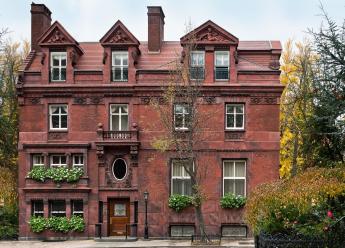
|
| Frank Furness Home |
As a matter of fact, that's the remaining problem for these places, the rate-limiting factor as chemists say. Automatic washers, microwaves, electric sweepers, spray-on cleaning fluids and similar advances are the new industrial revolution which makes these hulking mansions almost practical. What's still lacking is the social structure of Upstairs and Downstairs, the servant community overseen by the lady of the house, who once was sort of the Mayor of a town. The lady of the house is now a partner in a big law firm, or similar. It simply is not wise to leave a big expensive place unattended by someone constantly supervising the domestic help. It is never entirely safe to leave the financial affairs of the household in the hands of someone who is not a central member of the owning family. Perhaps the father of the family can be brow-beaten into spending some quality time with the children once in a while.
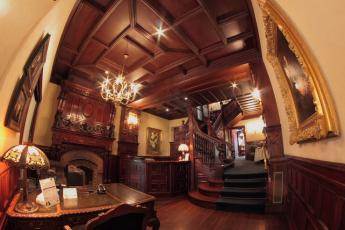
|
| Structure of Upstairs and Downstairs |
Perhaps an accountant can for a fee be trusted with the finances; perhaps a butler can be found who will whack the staff when they get out of line. But the plain fact is these monster houses were built around the assumption that the lady of the house would run them, and the old style of manorial life cannot return unless the house is completely redesigned for it. Someday, perhaps a genius of the Frank Furness sort will make an appearance, change everything, and make everybody want to have it. But it is asking for something else when you insist on this happening in an old stone fortress that was designed to house a different style of life.
Greenhouses

|
There are lots of mundane activities involved in having a prize show garden, like compost heaps, cold frames, mud rooms, and the like, which competitive show-gardeners never think of talking about, let alone putting on display. However, someone who feels very competitive about the garden usually lets that competitiveness spill over into the greenhouse. Most working greenhouses are muddy and disreputable-looking. When you see a big greenhouse with a spotless floor, however, you know you are learning something about the owner. When tidiness extends to spotless tools and well-sharpened pencils, there's a message. This greenhouse is not merely a tool shed, it's part of the display.
Let's talk about three outstanding greenhouses in the Philadelphia region which are adjuncts to three outstanding horticultural competitors. To spare the feelings of all concerned, the names of the owners will not be mentioned. In one case, the plants are preponderantly indoor plants, a second one is preponderantly filled with outdoor plants, and the third is full of rarities.
The greenhouse full of indoor plants reflects an owner who primarily competes in flower shows in that type of plant, it is true. But this lady obviously brings the flowers to a peak of perfection and then shifts them into the house. The result is a dining area with twenty-five potted flowers scattered tastefully around, dressing up the house. One presumes the flower pots go back to the greenhouse when they start to wilt a little, and probably an effort is made to have plants which flower at different seasons of the year. Back out in the greenhouse, there are dozens of blue ribbons arranged within picture frames to produce pleasing arrangements in themselves. Although this is a famous horticulturalist of long standing, the blue ribbons on display are only awards from fairly recent shows.

|
The second greenhouse to be mentioned is primarily devoted to outdoor plants, being bred and hybridized in controlled circumstances. The owner has created a garden in the interior of a suburban block on the Main Line, and although the houses are all part of the estate, the effect is one of the certain types of plantings in several backyards, a set of sculpted topiaries in one, a formal arrangement of boxwood designs in another, annuals in another. Although the rotation of plantings back and forth from the greenhouse is here probably more of a one-way trip, essentially the greenhouse is serving the same function as the one servicing the indoor display, a place to nurture plantings which are not quite ready for prime time.

|
And the third greenhouse is primarily run by a husband and wife team of horticultural competitors. The other two gardens look as though they employed a dozen or so gardeners, while this one looks like it supports a two-person hobby. It contains a most unusual fern with its own nickname, and dozens of other display specimens of rare and unusual plants to compete in specialty shows of particular varieties. This greenhouse is just as spotless as the ones with much larger staff to do the cleaning, but it seems to have a wider variety of gardener conveniences to lighten the load and increase productivity. One quickly senses that the husband of the team pores over greenhouse catalogs and quickly adopts labor-saving devices. Space is at a premium in this greenhouse, and one guesses its results as much from a need to conserve steps as to conserve space. The effect faintly starts to resemble the jam-packed cockpit of a space-ship.
One technology advance seems to be so superior they all have it. The exterior surface of the greenhouses is not made of glass, but of polycarbonate plastic, sometimes known as "bullet-proof glass". Greenhouses seem a safe enough use for polycarbonate, although widespread use in disposable plastic water bottles seems a more questionable direction for environmental enthusiasm. This transparent material admits the light of a much wider wavelength, particularly ultra-violet, and no doubt greatly extends the season and the effectiveness of indoor nurture. From the photographer's point of view, the resulting pictures are far more pleasing, with diffused light and greater color brilliance. Thus, science has finally achieved for the Philadelphia region the same striking color of light that was so attractive to French Impressionists in southern France, and to vacationers in Hawaii.
The other thing this plastic invention has done has been to increase the general attractiveness of greenhouses. Until rather recently, it was the custom to paint white-wash on the glass and let it slowly weather away as increased sunlight is needed for the plants. Thus, greenhouses once almost always looked shabby and disreputable; not a place you would want seeing by visitors. But nowadays, you just keep them spic and span. And hold a cocktail party there.
REFERENCES
| Standardized Plant Names: American Joint Committee on Horticultural, Frederick Law Olmsted | Google Books |
Green Roof at Peco

|
| PECO Building |
The Horticulture Society, the Hort to locals, recently conducted a tour of the green roof which Philadelphia Electric, now Exelon has put on the top of that big black building across the street from 30th Street Station. It's a large flat roof, and the ten varieties of sedum are quite handsome.
It's a public service activity, however, designed to help the environmental movement get up some momentum. When you look out at the Philadelphia landscape from the top of a skyscraper, it's possible to see a whole new dimension to the city. On its top, Philadelphia is one huge sea of roofs. If all of those roofs were planted, it would indeed make a huge difference of some sort. Unfortunately, the vast majority of those roofs are residential, slant-roofed, and small.
The Peco roof involved a considerable amount of tailor-made work which would have to be streamlined to make it practical for residences. First, a waterproof liner is put down, then layers of artificial plastic dirt on cushioning layers. Then the plant layer is unrolled, filled with seeds and sprouts of ten different varieties of sedum. Over time, Darwinism takes over, to make the most suitable variety of sedum thrive in the areas most advantageous to it, probably with some judicious watering to get it all started. The result is to reduce the roof temperature in summer from around 160 degrees to 70 degrees, with a consequent reduction in air conditioning costs. It does look rather pretty.
But then some hard facts of economics enter into the discussion. The roof is thought to last fifty years instead of the usual twenty since most deterioration is due to sunlight. Most homeowners don't last fifty years, however, and in fact, the average duration of ownership is around seven years. Most homeowners are skeptical they could pass on the cost to the next owner, and therefore are dubious of promised savings. Churches, museums and public buildings are therefore the most likely market in the early going. The Quakers, as usual, were the first adopters, for their administrative center at fifteenth and Cherry.
And then, there is the height of the building, which is sort of a catch-22. The taller the building, the smaller the proportion of cost savings to the owner; for the most part, the lower stories of a skyscraper are unaffected by what's on the roof. So, office buildings are unlikely to take up the green roof revolution first, or for strictly economic reasons. That leaves mostly residential roofs, which are mostly slanted in this town; the Bauhaus movement hasn't caught on much in this country. It has made more progress in Germany, and Tel Aviv is said to be predominantly Bauhaus. Consequently, we hear tales of these cities getting ahead of us, but it figures. It will be a long time before what Weir Mitchell called The Red City gets rebuilt in a flat-roof style. The proponents feel that green roofs can be adapted to slant-roof structures, but the objections to snow and rain accumulations are obvious obstacles to a city-wide transformation which would even so take a very long time.
There's even a problem with birds, who tend to drop weed seeds where ever they roost. Crabgrass, for example, is an annual which dies each year. Not everybody is willing to devote time every summer to pulling crabgrass off the roof. So, here's another advantage for skyscrapers, which is to say a disadvantage for houses. And some financial wizardry has got to be devised to pass the green roof investment of thousands of houses on to the next, skeptical, owners. And inventors and tinkerers have got to find a thousand little ways to make this process cheaper; at present, it takes too many different tradesmen and artisans to put it all together. In short, it probably costs too much at present to hope to be popular.
Our reaction here is generally favorable to the idea but skeptical of the economics. Except for altruists, idealists, and experimenters. It would seem very fine if more people took it up and perfected it. Meanwhile, it may really not be "ready", as the Quaker says.
Governor Keith's House
Route 611 begins at Philadelphia's City Hall and goes due north, headed for the Delaware Water Gap. In 1717 Lieutenant Governor Sir William Keith had decided he needed a summer residence to compliment his in-town establishment on Second Street, and acquired the 1200 acres of land of Samuel Carpenter on Easton Road, now Route 611. Sam had been entrusted with 2000 pounds against a possible French invasion, which Keith transferred to himself by taking Carpenter's land in lieu of it. The ethics of everybody in this transaction are now a little murky. The selected farm area was cool and tranquil, with creeks and level land, so a suitable three-story mansion was built of local stone, with outbuildings. A large mushroom-shaped rock was carved, polished and set on a pedestal beside the house. Tradition has it that Governor Keith asked servants and slaves to lift the stone as a test of physical strength. Keith had several negro slaves, eight or ten indentured servants, and others who were simply hired help for a rather large farm. Criticism was heard for the elaborate luxury of a mansion fifteen miles from town which it took five or six hours to reach.
Governor Keith was an interesting person. He inherited a Scottish baronetcy from his father and is the only Governor of Pennsylvania with a claim to noble blood. His finances were meager, however, and his life was a succession of efforts to advance his own wealth and position, which he regularly consumed with high living. He involved himself in coups and rebellions in Scotland, probably out of expectation of reward from the exiled King James. Efforts at court were finally rewarded by Queen Anne making him Surveyor-General of English land from Pennsylvania to Jamaica, but only after his nearly being hanged for treason for suspected efforts on behalf of the exiled former King James. Keith lost this essentially tax-collector position which he had performed creditably when the Hanoverian King George I took over the throne. After William Penn encountered difficulties which returned him to England, he and the Penn family were in need of an administrator in America, and Keith was at pains to ingratiate himself with Hannah Penn after William suffered several strokes from which he was to die in 1718. Most who met him felt that Keith was charming, although some regarded him as a charming rogue; he succeeded in ingratiating himself to the Penns and was appointed Lieutenant Governor of Pennsylvania in 1716, incurring substantial debts to transfer his family to America in style. After taking office, he wasted no time starting schemes and devices to enrich himself, while at the same time pursuing a populist political style which involved him in more or less constant controversy. There are many echoes in his career of that enduring subsequent conflict in America between creditors and debtors; as probably the most indebted man in Pennsylvania, his populism was highly troubling to conservative Quaker farmers. He pushed hard for paper currency, always popular among debtors, and probably sought to soften the feelings of the Quakers by pushing hard for the replacement of legally binding oaths with secular "affirmations". By doing so, however, Keith infuriated the vestry of Christ Church, representing widely held Anglican support for requiring oaths. Keith's pandering to differing viewpoints succeeded in infuriating James Logan, the secretary of the Penn proprietorship, into setting sail for England to seek Keith's removal from office. Logan only returned with a letter of admonishment from Hannah Penn, and controversy continued to simmer. Reduced to its essentials, a case can be made that Keith behaved like an unrestrained modern machine politician exploiting every opportunity he could find.

However, certain things can be said in Keith's defense. There is no doubt the Quaker farmers were hypersensitive about the display of wealth which a Scottish baronet would find quite appropriate for a man in his station. His mansion, for example, would barely qualify today as a five-bedroom house in the suburbs, and it is a little quaint to recall that generations of Penrose's and Strawbridge's subsequently lived on the property quite proudly, or even defiantly in view of their ample means. Paper money is indeed always the favorite of debtors who seek to dishonor their debts, but the colonies in Keith's times were suffering from a severe lack of space which can now be explained as the consequence of colonial terms of trade but which at that time was a severe economic hardship. His efforts to stop the practice of executing debtors may well have been made with his own indebtedness in the back of his mind, but still, it seems like a step in the right direction. Even the inventory of his property probably exaggerates the ostentation of his lifestyle. True, he had 144 chairs in the house, but the shortage of currency at that time had converted chairs into a form of exchangeable value, employed by almost every shopkeeper. Land was similarly used as a form of currency, although here most people would raise their eyebrows at a governor accumulating in eight years a list of property including not only this country estate and the downtown house in Society Hill, but a dozen rather large estates in other colonies, and a particularly troublesome investment in a copper mine on the west side of the Susquehanna. To some degree, Keith was a good Governor but was forced into a number of conflicts between the wishes of the settlers and the best interest of the Penn proprietors. Three thousand miles from the Court of St. James, he would scarcely be expected to display universal agility in shifting allegiance between the Stuart Kings, Queen Anne and the Hanoverian King George I, not to mention the Penn family and the settlers on their land. Keith did maintain reasonable stability in the colony while seeming to undermine the best interests of the Penn family. He was said to have made shrewd business decisions for the whole region converting surplus grain into malt at a time of money shortages in the colony, even though it particularly profited his own acreage. In some ways, his reputation remains chiefly tarnished by his treatment of Benjamin Franklin. Encouraging Franklin to go to England to buy some printing equipment, Keith promised letters of credit for what was presumably intended as a joint venture. The letters were never forthcoming, Franklin was stranded for months in England without means to return home. Franklin got his revenge years later in his autobiography. This was not the only example of Franklin nursing a grudge for decades. Poor Keith returned to England to defend himself against dismissal by the Penns because of all the turmoil and factionalism, but essentially never got another job and died in debtors prison. During that time he published extensively about current affairs and economics, but the value of that writing is now difficult to judge.
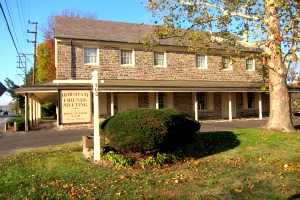
|
| Horsham Friends Meeting |
After Keith returned to England in 1726, presumably to defend his interests and possibly to evade his creditors, the mansion and estate on County Line Road was sold to Keith's son in law, Dr. Thomas Graeme who was a physician at the founding of the Pennsylvania Hospital in 1751 and evidently had become quite prosperous. Graeme paneled the interior of the mansion in high Georgian style, revised the floor plan, generally making the place elegant. Records of how the region between the counties became named Graeme Park, but presumably Graeme would now put up no objection to it. A second house on the property was home to several generations of Penrose's and Strawbridge's; the Strawbridge family donated the estate as a park. Governor Keith having left his wife forever to her distress alone, fathered two illegitimate children in England, making his prevailing emotions subject to uncertainty.
Around the corner, so to speak, on Route 611 the Horsham Friends Meeting is built of the same sort of stonework, with dates which suggest the meeting itself was present well before Keith appeared on the scene, and the string of similar but tavern-like buildings along 611 suggest the highway to Easton was a busy one even at an early time. Increasing traffic and construction carry an ominous prediction that growth of the area will eventually swallow both Graeme Park and Horsham Meeting in a sea of subdivisions and industrial parks. Placing a turnpike entrance nearby almost certainly hastened that fate.
Helping the home owner
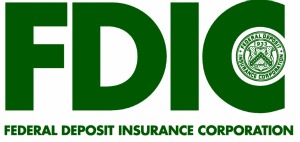
|
| FDIC LOGO |
The Treasury's lender/investor support programs may have stopped October's (2008) bank-run and foreclosure panic. But it is generally agreed the crisis would not bottom and turn around until a way is found to slow the fall in house prices, the root cause of the housing crisis.
Both the City of Boston and the FDIC (at IndyMac, which they now run) are trying to address the mortgage uproar at its source: the homeowner, in trouble after paying too much for a house. Cheap mortgages tempted him to overpay, so still deeper causes trace back to Far Eastern prosperity, supported by a Chinese currency pegged too low in order to stimulate exports. These grander visions will probably be topic of the November 15 monetary summit.
Meanwhile, Boston has dozens of blocks of foreclosed houses. That city is attacking its local problem from two directions: (1) matching up 1st-time home buyers with homeowners in distress and (2) working with mortgage servicers to adjust troubled mortgages. In both cases, the objective is to keep the houses occupied and out of foreclosure. But if new home buyers again pay too much for the house, the problem is not entirely solved.
Remember, there are three elements to a mortgage: principal, interest rate and term.
Adjusting the principal is currently off the table but efforts are being made to fix and lower the interest rate and lengthen the term so resulting payments do not exceed 38% of gross monthly income. Sometimes this can't be done and the homeowner loses the home. But it helps quite a number of people.
Interest modification is resulting in mortgage terms of 40 or 50 years. That sounds almost like indentured servitude but at least such grass-roots efforts are starting to provide some relief for those who were swept into the housing bubble.
(It's interesting that one unintended consequence of securitization is that the counterparty to these negotiations is the mortgage servicer, not the original lender or the current holder. The effect of this is to reduce the natural resistance of a bank to lend more than it thinks the house is currently worth. Original lenders are a new mix of people; they sold the mortgage on to the current holders, who are a widely diffuse group of investors, both institutional and retail, who in most cases also cannot easily be identified. An exception is that in several cases where attempts were made to adjust the principal instead of the interest or the term, class-action lawsuits were initiated by several hedge-fund investors. That mainly explains why adjustments to interest rate and term are the current focus rather than principal. For obvious reasons, stock market short-sales seldom evoke the same response, at least from hedge funds.)
Ageing Owners, Ageing Property

|
| Kiyohiko Nishimura |
Kiyohiko Nishimura is currently the Deputy Governor of the Bank of Japan (BOJ), and as such is expected to have wise things to say about finances, as indeed he does. Japan has a far older culture than the United States, and a botanical uniqueness growing out of the glaciers avoiding it, many thousands of years ago. But its latitude is approximately the same as ours, and its modern culture is affected by the deliberate effort of the Emperor to westernize the nation, following its "opening up" by our own Commodore Matthew Perry in 1852. Perhaps a more important relationship between the two cultures for present purposes is that Japan has been suffering from the current deep recession for fourteen years longer than we have. We don't want to repeat that performance, but we can certainly learn from it.
Mr. Nishimura lays great stress on the aging of the Japanese population because, in all nations, houses are mainly purchased by young newly-weds, and sold by that same generation years later as they prepare to retire. If a nation has an elderly population, it can expect a general lowering of house prices someday, reflecting too many sellers leaving the market at the same time. The buyers of those houses are competing with other young people, so the simultaneous bulges and dips of the population at later stages combine to have major effects on housing prices. At the moment, younger couples are having fewer children as a result of women postponing the first one. Nishimura goes on to reflect that something like the same is true of stocks and bonds, although at age levels five or ten years later. One implication is that retirement of our own World War II baby boom is about to depress American home prices, which will likely stay lower for 10-20 more years. Furthermore, our stock market will have a similar effect, stretching the depression out by as much as 5-15 years. The Japanese stock market has been a gloomy place to be during the past fifteen years, and by these lights might continue in the doldrums for another five or so. Meanwhile, our own situation predicts an additional generation of struggle while Japan is recovering. It's best not to apply these ideas too closely, of course, but surely somebody in our government ought to dig around in the data, at least telling us why we ain't goin' to repeat this pattern. Please.
Perhaps because they eat so much rice and fish, the Japanese already have a longer life expectancy than Americans do, but in terms of outliving your assets, that's not wholly advantageous, the way a love of golf might be. The best our nation might be able to do is to examine some of our premises about housing construction. In Kyoto, most houses were built with paper walls, for example.

|
| Commodore Matthew Perry and Japan |
The house walls of the town of Kyoto were in fact made of waxed paper, which seems to work remarkably well. While no one now advocates going quite that far, we might think a second time about building the big hulking masonry houses so favored in our affluent suburbs. Such cumbersome building materials almost dictate custom building and strongly discourage mass production. How likely are such fortresses to survive in the real estate markets of fifty years from now? Judging from my home town, not too well. Haddonfield boasts it has been around since 1701, and there are at most three or four of its houses which have survived that long. We favor great hulking Victorian frame houses, with a good many bedrooms unoccupied, and high drafty ceilings, very large window openings and little original insulation. The heating arrangements have gone from fireplaces to coal furnaces, to oil, and lately to natural gas. The meter reader who checks my consumption every month tells me that almost all the houses now have gas heat, so almost all the houses are using their second or third heating plant, along with their eighth or tenth roof, and thirty coats of paint. This kind of maintenance is not prohibitively expensive, but just wait until the plumbing starts to go, and leak, and freeze, with attendant plastering, carpentry, and painting. Our schools and transportation are excellent, so we have location, location, location. But when the plumbing, heating, and roofing start to require financial infusions all at once, you get tear-downs. A tear-down is a new house in which a specialist builder buys the old house, tears it down, and looks for a buyer to commission the new house on an old plot of land. Right now, there appear to be six or eight such Haddonfield houses, torn down and looking for a buyer to commission a new house on that location, location. If we repeat the Japanese experience, there will be some unhappy people, somewhere. And that will include the neighbors like me, who generally do not relish languishing vacant lots next door, but fear what the new one will be like.

|
| Greenfield Hall |
The thought has to occur to somebody that building the whole town of less substantial materials in the first place would be worth investigation, replacing the houses every forty years when the major stuff wears out. At the present, when a town of several thousand houses has five or six tear-downs, the neighbors would not tolerate replacing tear-downs with insubstantial cardboard boxes. Seeing what has happened to inner-city school systems, the neighbors would be uneasy about "affordable housing" built in place of stately old Homes of Pride. In time, that might lead to a deterioration of one of the two pillars of location, location -- the schools -- and hence to a massive loss of asset value. And yet when those houses empty out the school children, leaving only retirees in place, the schools will not be worth much to the owners or in time to anybody else. There's an unfortunate tendency for local political control to migrate into the hands of local real estate brokers, so you had better be sure any bright new proposal is tightly buttressed with facts.
The only real hope for evolution in this obsolete system may lie in the schools of architecture, strengthened perhaps by some research grants. Countless World Fairs have displayed the proud products of their imaginative thinking, but mostly to no avail. Perhaps the ideas are not yet ripe, but since it would take more than a generation to create a useful demonstration project of whatever does become ripe for decision, let's start thinking about some innovative suburban designs, right now.
A Few Rooms of Your Own
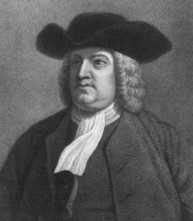
|
| William Penn |
If William Penn could revisit Philadelphia today, he would surely feel disappointed that the Greene Country Towne still hasn't materialized. Even a century after Penn's real visits, Philadelphia at the time of the Revolutionary War still nestled East of Fifth Street. There have been many conjectures about this, perhaps fear of Indian attack, perhaps lack of firewood, desire to be near the port, perhaps a number of things. Let's examine whether it's just the nature of a successful city to organize itself the way it does.
Ancient Athens, for example, was a nice warm place without much rain, which possibly accounts for the miserable little hovels where people lived, contrasting with the magnificent Acropolis, Parthenon, Stoa and other public buildings. It has been speculated that the architecture created the social system, not the other way around; the same contrast between big stone temples and little wooden huts is also seen in the Mayan cities of Yucatan. Hong Kong certainly isn't poor, but it's built like that. Japan cannot claim that lack of land forces the citizens to live in tiny apartments. It's hard to say whether the lowly social state of Japanese women accounts for the contrast between where they live and where their husbands spend most of their time because it's just as easy to believe the proposed cause is really an effect.
The more you look around the world, the more you wonder if it isn't the American suburb that's out of step with the world. When they can afford it, hardly any of the world seems to want to live in the suburbs; their homes are seldom their castles. There's New York City, of course. New Yorkers seem to like living in high-rises.
An architect friend makes short work of construction economics as a driving feature. According to him, it is unduly expensive to live in a high-rise. Just a pointless ego trip. The cost per square foot of usable floor space just keeps going up as the building gets taller, requiring more elevator shafts, more elaborate HVAC. That's heating, ventilating and air conditioning. Everything has to be built with a derrick, the traffic congestion at the base is horrific, high winds can break the window glass. The list rapidly grows convincing. Why does anyone pay all that extra money to live high in the sky? Not my idea of something to do, says Cole Porter.
Notice there is a major difference between sleeping in the suburbs as they do in Japan, and sleeping in apartments right near the center of town, as they do in Budapest, Berlin, Prague, and Vienna. The Orientals are staying close to work for longer hours, while the Central Europeans are staying close to the cafes and theaters to which they flock the moment work is over. Just what to think of the Spanish siesta system isn't clear, but it seems to have the main effect of bringing people back into the center of the town at night. You can't live very far away from work if you have to commute twice a day.
The Lord only knows where everybody in New York is going every Friday night, with return traffic jams in the other direction on Sunday night. The weekly exodus suggests they don't really luxuriate in their penthouses or flock to their entertainment district on weekends; apparently, a cabin in the woods is beckoning. As, by contrast, the empty nesters in the suburbs eventually look around for retirement villages to live, repeating the endless complaint about the nuisance of maintaining a big house and garden. Pennsbury looks like a comfortable place to live, but even William Penn seems to have tired of it. One really does have to wonder whether a heart's desire in architecture all too frequently leads to heart's discontent in lifestyle. Philadelphia appears to be trying a new approach; the suburbs are moving back downtown.
We'll eventually see if it changes our character and lifestyle so somebody can write sociology books about it.
Relocation

|
| Moving Truck |
For many decades, at least since the Second World War, the Northeastern part of the country has been losing population. And business, and wealth. In recent years, New Jersey has been the state with the greatest net loss, and the Governor who is making the greatest fuss about it. Statisticians have raised this observation to the level of proven fact, although lots of people are even moving into New Jersey at the same time. This is a net figure, and it remains debatable what sort of person you would want to gain, hate to lose; so it's hard for politicians to be certain whether New Jersey's demographic shifts are currently a good thing or a bad thing.
Take the prison population, for example. Most people in New Jersey would think it was a good thing if the felons all moved to some other state because it would imply less crime and law enforcement costs. But one of the major recent causes of a decline in violent crime seems to be the universal presence of a portable telephone in everyone's pocket. Just let someone yell, "Stick 'em up!" loud enough, and thirty cell phones are apt to emerge, all dialing 911. On the other hand, cell phones are the universal communication vehicle for sales of illicit drugs and other illegal recreations, and the increase in automobile accidents is a serious business for inattentive drivers. Add to this confusion the data that capital punishment is more expensive for the State than incarceration is, and you start to see the near futility of knowing what is best to have more, or less, of.
What the Governor and his Department of Treasury mostly want to know is whether certain taxes end up producing a good net revenue for the State. That is, whether more revenue is produced by raising certain taxes more than others, or whether some taxes are a big component of the Laffer Curve, causing revenue to be lost by driving business, or business owners, out of state, in spite of the immediate revenue gain. The studies which have been done are fairly conclusive that executives tend to be most outraged by property taxes, since they have a hidden effect on the sale price of the house, and the amount of money available for school improvements. At least at present levels, a Governor is better off taking abuse for raising income or sales taxes, even though the apparent tax revenue might be the same as a rise in property taxes. Since property taxes are mostly set by a local municipal government, while sales and income taxes are usually set by state governments, a decision to raise one sort of tax or another can have unexpected consequences, or require obscure manipulations to accomplish.
Some politicians who believe their voting strength does not lie in the middle class, would normally want to hold up property values, not taxes because the data show that higher home prices drive away from the middle class and in certain circumstances are positively attractive to wealthy ones. Higher prices appeal to home sellers, at least up to a point. Wealthier people who are buying houses are likely to have an old one to sell; that's less true of first-time home buyers or people presently renting. Certain issues can even be reduced to rough formulas: a 1% increase in income tax would cause a 1% loss of population, but a 5% loss of people earning more than $125,000. A $10,000 increase in average home prices, on the other hand, causes a net loss of population, but mostly those with lower income. One important feature of tinkering with average home prices and property taxes is that these effects are "durable" -- they do not fade away over time.

|
| Laffer Curve |
New Jersey is financially a bad state to die in, but the decision to move to Delaware, Florida or Texas is often made over a long period of years in advance of actually doing it. It has been hard to compile statistics relating changes in inheritance tax law to net migration of retirees and to present such dry data in an effective manner to counteract the grumblings that rich people are undeserving of tax relief, or dead people are unable to complain. But rich old folks are very likely to own or control businesses, and if you drive them out of state, you may drive away a considerably larger amount of taxation relating to the business in other ways. This is the underlying complaint of Unions about Jobs, Jobs, Jobs; but state revenue also relates to sales taxes of the business, business taxes, employee taxes, real estate taxes on the business property, etc, etc. Sometimes these effects are more noticeable in the region they affect; the huge population growth of the Lehigh Valley in recent years is mainly composed of former New Jersey suburbanites, who formerly earned their income in New York. The taxes of three different states interact, in places like that.
The audience of a group I recently attended contained a great many people who make a living trying to persuade businesses to move into one of the three Quaker states of the Delaware Valley. The side-bar badinage of these people tended to agree that many of the decisions to relocate a business are based on seemingly capricious thinking. The decision to consider relocation to the Delaware Valley is often prompted by such things as the wife of an executive having gone to school on the Main Line. Following that, the professional persuaders move in with data about tax rates, average home prices, and the ranking of local school quality by analysts. Having compiled a short list of places to consider by this process, it all seemingly comes back to the same capriciousness. The wife of the C.E.O. had a roommate at college who still lives in the area. And she says the Philadelphia Flower Show is the best there is. So, fourteen thousand employees soon get a letter, telling them we are going to move.
And, the poor Governor is left out of the real decision-making entirely, except to the degree he recognizes that home property taxes have the largest provable effect on personal relocation. And lowering the corporate income tax has the biggest demonstrable effect on moving businesses. But the largest un-provable effect is dependent on the comparative level of the state's inheritance tax.
Gas House, the Real Thing

|
| Lou Durocher |
Gas House Gang is what Leo Durocher called the St. Louis Cardinals because of their scruffy appearance. One suspects he was really bragging about his once playing for the New York Yankees, a distinctly upscale background, in his view.

|
| Gas House Gang |
But there really once were gas houses, and a somewhat used one still exists on the Foerderer estate, Glen Ford, open to the public (on request) in the tiny village of Torresdale. We have this information from Meg Sharp Walton, the director of the Glen Foerd Museum. Waltons have lived in the area since 1675, about a decade before William Penn arrived, so they ought to know about these things. According to her, the gas house supplied gas for the surrounding houses before the days of household electricity. Every Monday, the gas house burned something she knows not what, to produce gas.
What else would you call such a place, except a gas house?
| Posted by: Billy Turner | Mar 23, 2017 9:34 AM |
13 Blogs
Home Heating Issues
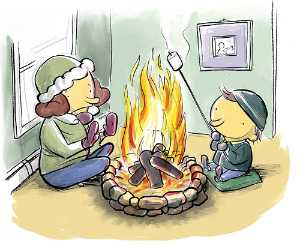 There are very few places in America where home heating is unnecessary. Here are a few thoughts, from the home owner's point of view.
There are very few places in America where home heating is unnecessary. Here are a few thoughts, from the home owner's point of view.
Supra Complex Heating Systems
Because of international events and recent discoveries in shale gas extraction, home gas heat is cheaper than burning oil; that may change. Instead of replacing systems, just add a new one of the other design. By using two thermostats, switch from one to the other at will.
Bergdoll the Rich Draft Dodger

Selling Entire Towns
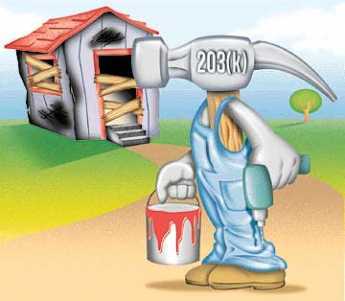 Some builders build whole towns without houses and then sell them to custom home builders.
Some builders build whole towns without houses and then sell them to custom home builders.
Frank Furness (2) Rittenhouse Square
 There were plenty of rich folks in Philadelphia before the Civil War. But it took the industrial revolution to make possible what we call the Victorian urban mansions.
There were plenty of rich folks in Philadelphia before the Civil War. But it took the industrial revolution to make possible what we call the Victorian urban mansions.
Greenhouses
 A greenhouse is a greenhouse, until you know something about them.
A greenhouse is a greenhouse, until you know something about them.
Green Roof at Peco
 That big black electric company building across from 30th Street Station has a green roof. That is, they have planted sedum on it, and it's attractive to visit. Economics is another matter.
That big black electric company building across from 30th Street Station has a green roof. That is, they have planted sedum on it, and it's attractive to visit. Economics is another matter.
Governor Keith's House

Helping the home owner
 The Treasury's support may have stopped the bank-run panic but the mortgage crisis will not bottom out until house prices stop falling, the root cause of the crisis. Unfortunately, house prices are still no bargain.
The Treasury's support may have stopped the bank-run panic but the mortgage crisis will not bottom out until house prices stop falling, the root cause of the crisis. Unfortunately, house prices are still no bargain.
Ageing Owners, Ageing Property
 From Japan, we get a fresh view of our assets. Kiyohiko Nishimura observes that the price of a house, even of a stock portfolio, has something to do with the age of the owner who is selling it.
From Japan, we get a fresh view of our assets. Kiyohiko Nishimura observes that the price of a house, even of a stock portfolio, has something to do with the age of the owner who is selling it.
A Few Rooms of Your Own
 The way we live changes what we are.
The way we live changes what we are.
Relocation
 Moving your place of residence has many influences, but property taxes seem to have the biggest influence on business executives decided to move. By contrast, property prices have the biggest influence on the middle class.
Moving your place of residence has many influences, but property taxes seem to have the biggest influence on business executives decided to move. By contrast, property prices have the biggest influence on the middle class.
Gas House, the Real Thing
 Gas Houses have disappeared, and what remains is Leo Durocher's phrase for the St. Louis Cardinals: gashouse gang. But gas houses were a real thing, and one even survives at Glen Foerd, the Foederer estate.
Gas Houses have disappeared, and what remains is Leo Durocher's phrase for the St. Louis Cardinals: gashouse gang. But gas houses were a real thing, and one even survives at Glen Foerd, the Foederer estate.